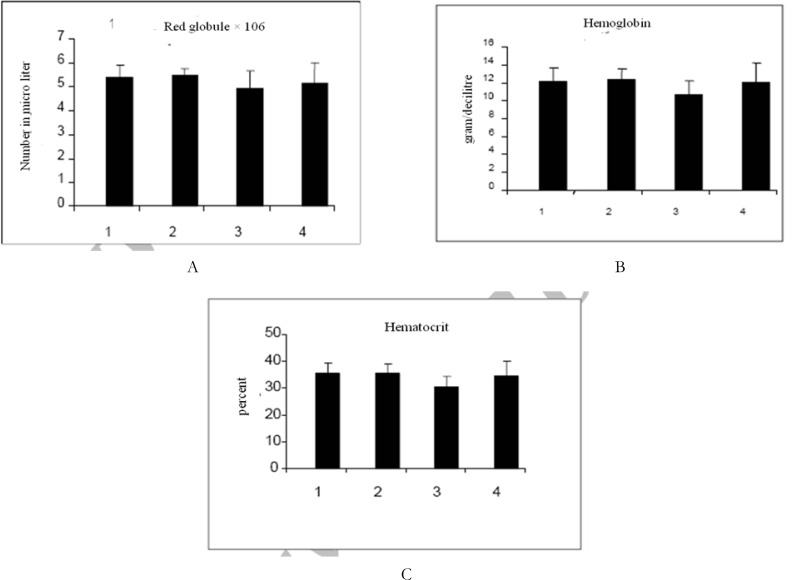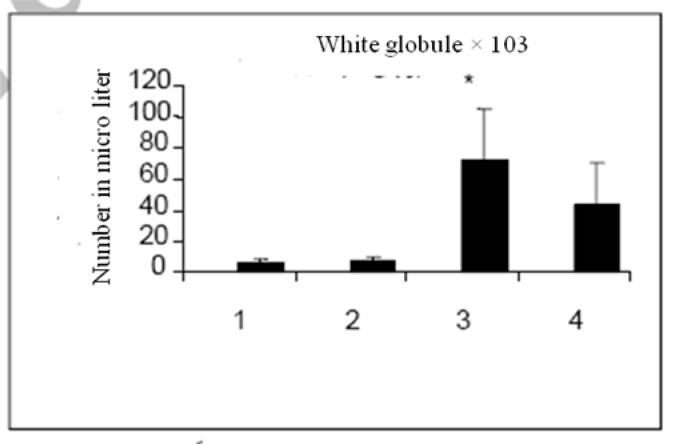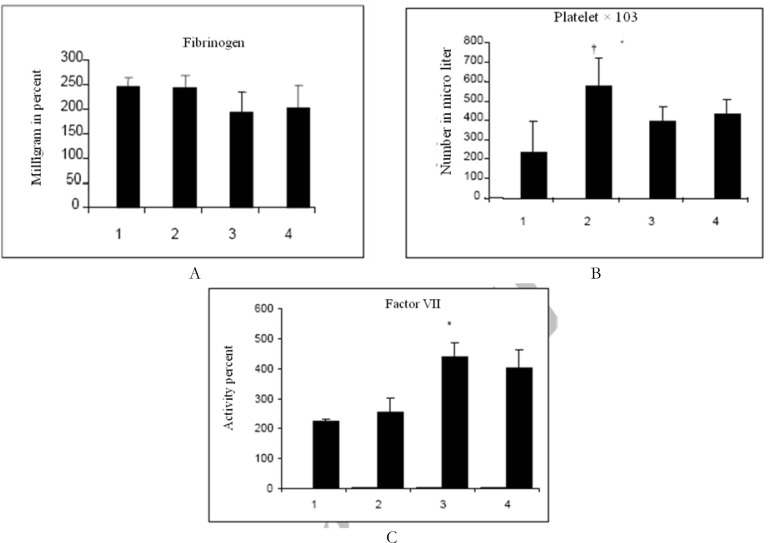Abstract
BACKGROUND:
Hypercholesterolemia is among the most common health problems treated with traditional remedies. Nigella sativa (NS) is an effective plant for treating hypercholesterolemia. However, the effects of this herb on hematologic factors and hemostasis system have not been elucidated. This study was designed to investigate the effects of NS on these factors in both normal and hypercholesterolemic rabbits.
METHODS:
In this research, twenty rabbits were randomly distributed into four groups of five. The groups received four different diets, namely normal, normal + NS (5%), hypercholesterolemic (1% cholesterol), and hypercholesterolemic (1% cholesterol) + NS (5%), for 8 weeks. After this period, WBC (white blood cell), RBC (red blood cell), HTC (hematocrit), HGB (hemoglobin content), PLT (platelet), fibrinogen (FIB) and factors VII (F VII) were measured.
RESULTS:
Using NS significantly increased PLT count in the normal group. In addition, it significantly decreased WBC counts in the hypercholesterolemic group (P < 0.05). However, dietary use of NS did not have any effects on other hematologic factors including RBC, HTC, HGB, FIB, and F VII (P < 0.05).
CONCLUSION:
Increased PLT numbers might cause enhanced coagulation. The achieved results call for more research on the effects of various diets (hypercholesterolemic and normal diet) supplemented with NS on different coagulation factors and hemostasis system.
Keywords: Hematological Factors, Hypercholesterolemia, Nigella Sativa L., Rabbit
Introduction
Plants have been an important source of medicine for thousands of years. The World Health Organization (WHO) estimated that up to 80% of people still rely on herbal remedies for their health care.1 Nigella sativa (NS) (Ranunculaceae), commonly known as “black cumin”, is an erect, herbaceous annual plant.2 Several beneficial pharmacological effects, including antihistaminergic, antihypertensive, hypoglycemic, antimicrobial, mast cell stabilizing and anti-inflammatory activities, have been attributed to various crude and purified components of black seeds.3–10 Researches support the traditional use of NS and its derivatives as a treatment for dyslipidemia and hyperglycemia.11 NS oil has hypocholesterolemic effects on patients with hyperlipidemia. Hyperlipidemic states, especially hypercholesterolemia, have been largely under consideration.12 Hypercholesterolemia is one of the crucial risk factors for the development of atherosclerosis and subsequent cardiovascular diseases.13 Cholesterol-rich diets are associated with free radicals production, followed by oxidative stress and hypercholesterolemia.14,15 Although the effects of NS on homeostasis is known in traditional medicine, the pharmacological investigations on the effects of NS on homeostasis are few.16 Al-Jishi did not find any changes in blood cells when NS oil was given to normal rats.17 Previous studies clearly showed that chronic treatment with NS fixed oil effectively influenced blood homeostasis in rats and seemed to induce transient changes in coagulation activity.11,18 In a study by Al-Hader et al., while NS fixed oil significantly decreased serum lipids and glucose levels, and leukocytes and platelets counts in rats, it significantly increased hematocrit and hemoglobin concentrations.19 However, treatment with NS extract has been reported to significantly protect mice and rats from cisplatin-induced falls in leukocytes counts,20,21 and to influence leukocytes activities.2,22
Anomalous results have been reported about the effects of NS on hematological factors and homeostasis system. Thus, we investigated the effects of NS on hematological factors and homeostasis.
Materials and Methods
Grouping and treatment
This experimental study and was carried out in 2006. It included 20 male 10-week old rabbits with a mean weight of 2–2.5 kg. The animals were provided by the Pasteur Institute and acclimatized under the standard rabbit chow basic diet for a period of 4 weeks before starting the experiment. Then, they were randomly divided into 4 groups of five, namely normal diet, normal diet + NS (5%), hypercholesterolemic diet (1% cholesterol) and hypercholesterolemic (1% cholesterol) + NS (5%). They were all treated under the special diets for 8 weeks.
Identifying and preparing the NS powder
NS seeds were obtained from Roshan Dasht in east of Isfahan. Genus and species of this plant were identified and authenticated by Iraj Mehregen, a botanist in the herbarium of Shiraz School of Pharmacology. NS was powdered using an electrical mill. It was then screened by a mesh device (number 20) to deliver a homogenous powder. Afterwards, 5 g of this was powder mixed with 95 g powdered basic diet. To prepare hypercholesterolemic diet, 1 g pure cholesterol powder was added to 99 g powdered basic diet.23
Biochemical factors measurement
After the 8-week period, blood was obtained from central sinus of the rabbits. Blood samples were used for biochemical factors analysis including WBC (white blood cell), RBC (red blood cell), HTC (hematocrit), HGB (hemoglobin content) and PLT (platelet) measurement. Plasma FIB (fibrinogen) and factor VII (F VII) were measured in Isfahan Cardiovascular Research Center and Blood Transfusion Center, respectively. The number of blood cells was determined by a cell counter. FIB was calculated according to clot formation time using Mahsa Yaran kit. In addition, F VII was estimated based on its percentage of activity in plasma by comparing clot formation time with a standard sample.
Statistical analysis
Statistical evaluations were conducted by SPSS13 and the results were expressed as mean ± SD. Kruskal-Wallis test was performed to compare the means of measured biochemical factors between the groups. Mann-Whitney test was applied for two by two comparisons.
Results
Based on the results, using NS in the normal group significantly increased platelet count (P < 0.05) but did not have any effects on other blood factors (WBC, RBC, HGB, HTC, FIB and F VII). Significant differences between normal and normal + NS (5%) groups confirmed these results (Figures 1, 2 and 3). As shown in the Figure 1 and 3, non-significant increases in RBC, HGB, HCT, FIB and PLT and a non-significant decrease F VII were observed in hypercholesterolemic (1% cholesterol) + NS (5%) group compared with the hypercholesterolemic group (1% cholesterol). Using NS in hypercholesterolemic diet (1% cholesterol) caused a significant decrease in WBC (P < 0.05) (Figure 2).
Figure 1.
The effects of using NS on red blood cell counts (A), hemoglobin (B) and hematocrit (C) in rabbits under the normal and hypercholesterolemic diets (1% cholesterol) (1- normal group; 2- normal + NS (5%) group; 3- hypercholesterolemic group (1% cholesterol); 4- hypercholesterolemic (1% cholesterol) + NS (5%) group
Figure 2.
The effects of using NS on white blood cell counts in rabbits under the normal and hypercholesterolemic diets (1% cholesterol) (1% cholesterol) (1- normal group; 2- normal + NS (5%) group; 3- hypercholesterolemic group (1% cholesterol); 4- hypercholesterolemic [(1% cholesterol) + NS (5%) group]
* Significant difference means between hypercholesterolemic group (1% cholesterol) and normal group (P < 0.05)
Figure 3.
The effects of using NS on platelet (A), fibrinogen (B) and factor VII (C) in rabbits under the normal and hypercholesterolemic diet (1% cholesterol) (1- normal group; 2- normal + NS (5%) group; 3- hypercholesterolemic group (1% cholesterol); 4- hypercholesterolemic [(1% cholesterol) + NS (5%) group]
* Significant differences in means between hypercholesterolemic group (1% cholesterol) and normal group (P < 0.05).
† Significant differences in means between normal + NS (5%) group and normal group (P < 0.05)
Discussion
Previous research showed that use of NS enhanced decreased levels of HGB, WBC and RBC in rabbits treated with carbon tetrachloride.24 Aflatoxin can be causes hematological changes whereby using NS makes resistance in rabbits under the aflatoxin diet.25 This plant has been shown to modify established chaos in hematological parameters of diabetic rabbits and increase defensive mechanisms of body versus infection in these rabbits.26 For instance, NS improved anemia resulted from increased nonenzymatic glycosylation in membrane proteins of RBC in diabetics. This plant also decreases anemia via lipid peroxidation reduction in RBC hemolysis and does not affect RBC levels directly. Results of this research confirmed that NS does not have an effect on blood cells directly.
Decreased coagulation factor in hypercholesterolemic (1% cholesterol) + NS (5%) rabbits may be due to the effects this plant on cholesterol and triglycerides (TG) levels. The positive relation between F VII and cholesterol levels, especially TG, along with the non-significant difference in F VII between normal and normal + NS (5%) groups, suggest that NS reduces F VII through an effect on cholesterol and TG levels and does not directly affect this factor. Since PLT counts increased in this research, NS might have increased coagulation activity.
While Ghoneim et al. reported an enhancement of coagulation after parenteral administration of NS extract,27 El-Naggar and El-Deib reported an anticoagulant effect after oral administration of powdered NS seeds.28 Enomoto et al. found NS oil to have repressive effect on PLT accumulation and suggested it to have strong anticoagulation effects.29 On the other hand, AL-Jishi and Abuo used 360 mg/KgRat/day of NS for a period of 2 weeks and observed increased FIB levels and prolonged prothrombin time. Thus, coagulation and anticoagulation effects of the extract were simultaneously detected.18 It can be concluded that these effects existence jointly show different components effect of NS on various coagulation factors. Therefore, further research is needed to recognize the effects of different NS components on various factors of homeostasis system.
Footnotes
Conflict of Interests
Authors have no conflict of interests.
References
- 1.Farnsworth NR, Akerele O, Bingel AS, Soejarto DD, Guo Z. Medicinal plants in therapy. Bull World Health Organ. 1985;63(6):965–81. [PMC free article] [PubMed] [Google Scholar]
- 2.Houghton PJ, Zarka R, De las HB, Hoult JR. Fixed oil of Nigella sativa and derived thymoquinone inhibit eicosanoid generation in leukocytes and membrane lipid peroxidation. Planta Med. 1995;61(1):33–6. doi: 10.1055/s-2006-957994. [DOI] [PubMed] [Google Scholar]
- 3.El-Dakhakhny M. Studies on the Egyptian Nigella sativa L. IV. Some pharmacological properties of the seeds' active principle in comparison to its dihydro compound and its polymer. Arzneimittelforschung. 1965;15(10):1227–9. [PubMed] [Google Scholar]
- 4.Marozzi FJ, Kocialski AB, Malone MH. Studies on the antihistaminic effects of thymoquinone, thymohydroquinone and quercetin. Arzneimittelforschung. 1970;20(10):1574–7. [PubMed] [Google Scholar]
- 5.Salomi MJ, Nair SC, Panikkar KR. Inhibitory effects of Nigella sativa and saffron (Crocus sativus) on chemical carcinogenesis in mice. Nutr Cancer. 1991;16(1):67–72. doi: 10.1080/01635589109514142. [DOI] [PubMed] [Google Scholar]
- 6.Salomi NJ, Nair SC, Jayawardhanan KK, Varghese CD, Panikkar KR. Antitumour principles from Nigella sativa seeds. Cancer Lett. 1992;63(1):41–6. doi: 10.1016/0304-3835(92)90087-c. [DOI] [PubMed] [Google Scholar]
- 7.Chakravarty N. Inhibition of histamine release from mast cells by nigellone. Ann Allergy. 1993;70(3):237–42. [PubMed] [Google Scholar]
- 8.El Tahir KE, Ashour MM, Al-Harbi MM. The cardiovascular actions of the volatile oil of the black seed (Nigella sativa) in rats: elucidation of the mechanism of action. Gen Pharmacol. 1993;24(5):1123–31. doi: 10.1016/0306-3623(93)90359-6. [DOI] [PubMed] [Google Scholar]
- 9.Hailat N, Bataneh Z, Lafi S, Raweily E, Aqil M, Al-Katib M, et al. Effect of Nigella sativa volatile oil on Jurkat T cell leukemia polypeptides. Int J Pharmacog. 1995;33(1):16–20. [Google Scholar]
- 10.Zaoui A, Cherrah Y, Lacaille-Dubois MA, Settaf A, Amarouch H, Hassar M. [Diuretic and hypotensive effects of Nigella sativa in the spontaneously hypertensive rat] Therapie. 2000;55(3):379–82. [PubMed] [Google Scholar]
- 11.Zaoui A, Cherrah Y, Alaoui K, Mahassine N, Amarouch H, Hassar M. Effects of Nigella sativa fixed oil on blood homeostasis in rat. J Ethnopharmacol. 2002;79(1):23–6. doi: 10.1016/s0378-8741(01)00342-7. [DOI] [PubMed] [Google Scholar]
- 12.Tissera MH, Kadudunkorala M, Withanarachchi K. Effect of the combination of Black seed and garlic on Hypercholesterolemia Period of study January 2005 to January 2006 [Online] 2006. Available from: URL: http://www.barakaoil.com/Clinical_Trials_of_Baraka_Garlichol.pdf/
- 13.Steinberg D. Atherogenesis in perspective: hypercholesterolemia and inflammation as partners in crime. Nat Med. 2002;8(11):1211–7. doi: 10.1038/nm1102-1211. [DOI] [PubMed] [Google Scholar]
- 14.Stehbens WE. An appraisal of cholesterol feeding in experimental atherogenesis. Prog Cardiovasc Dis. 1986;29(2):107–28. doi: 10.1016/0033-0620(86)90021-6. [DOI] [PubMed] [Google Scholar]
- 15.Bulur H, Ozdemirler G, Oz B, Toker G, Ozturk M, Uysal M. High cholesterol diet supplemented with sunflower seed oil but not olive oil stimulates lipid peroxidation in plasma, liver, and aorta of rats. J Nutr Biochem. 1995;6:547–50. [Google Scholar]
- 16.Awad EM, Binder BR. In vitro induction of endothelial cell fibrinolytic alterations by Nigella sativa. Phytomedicine. 2005;12(3):194–202. doi: 10.1016/j.phymed.2003.09.008. [DOI] [PubMed] [Google Scholar]
- 17.Al-Jishi S. A study of Nigella sativa on blood hemostatie functions. 2000. [MSc Thesis]. Al-Ahsa: King Faisal University; [Google Scholar]
- 18.Al-Jishi SA, Abuo HB. Effect of Nigella sativa on blood hemostatic function in rats. J Ethnopharmacol. 2003;85(1):7–14. doi: 10.1016/s0378-8741(02)00356-2. [DOI] [PubMed] [Google Scholar]
- 19.Al-Hader A, Aqel M, Hasan Read Z. Hypoglycemic Effects of the Volatile Oil of Nigella sativa Seeds. Journal of Pharmacognosy. 1993;31(2):96–100. [Google Scholar]
- 20.Nair SC, Salomi MJ, Panikkar B, Panikkar KR. Modulatory effects of Crocus sativus and Nigella sativa extracts on cisplatin-induced toxicity in mice. J Ethnopharmacol. 1991;31(1):75–83. doi: 10.1016/0378-8741(91)90146-5. [DOI] [PubMed] [Google Scholar]
- 21.el Daly ES. Protective effect of cysteine and vitamin E, Crocus sativus and Nigella sativa extracts on cisplatin-induced toxicity in rats. J Pharm Belg. 1998;53(2):87–93. [PubMed] [Google Scholar]
- 22.Haq A, Abdullatif M, Lobo PI, Khabar KS, Sheth KV, al-Sedairy ST. Nigella sativa: effect on human lymphocytes and polymorphonuclear leukocyte phagocytic activity. Immunopharmacology. 1995;30(2):147–55. doi: 10.1016/0162-3109(95)00016-m. [DOI] [PubMed] [Google Scholar]
- 23.Aydemir EO, Duman C, Celik HA, Turgan N, Uysal A, Mutaf I, et al. Effects of defibrotide on aorta and brain malondialdehyde and antioxidants in cholesterol-induced atherosclerotic rabbits. Int J Clin Lab Res. 2000;30(2):101–7. doi: 10.1007/s005990070022. [DOI] [PubMed] [Google Scholar]
- 24.Meral I, Donmez N, Baydas B, Belge F, Kanter M. Effect of Nigella sativa L. on hrarth rate and some haematological values of alloxan-induced diabetic rabbits, scand. Scand J Lab Anim Sci. 2004;31(1):49–53. [Google Scholar]
- 25.Abdel-Wahhab MA, Aly SE. Antioxidant property of Nigella sativa (black cumin) and Syzygium aromaticum (clove) in rats during aflatoxicosis. J Appl Toxicol. 2005;25(3):218–23. doi: 10.1002/jat.1057. [DOI] [PubMed] [Google Scholar]
- 26.Meral I, Kanter M. Effects of Nigella sativa L. and Urtica dioica L. on selected mineral status and hematological values in CCl4-treated rats. Biol Trace Elem Res. 2003;96(1–3):263–70. doi: 10.1385/BTER:96:1-3:263. [DOI] [PubMed] [Google Scholar]
- 27.Ghoneim T, El-Alami R, Shoukry E, Yasseen S. Possible effect of some extracts of Nigella Sativa L. seeds on blood coagulation and fibrinolytic activity. Proceedings of the 2nd International Conference on Islamic Medicine; Studies in Islamic Medicine and Advantages of Herbal Treatment; 1982 March 29 to April 2; Kuwait, Kuwait. 1982. p. 12. 1982. [Google Scholar]
- 28.El-Naggar AM, El-Deib AM. A study of some biological activities of Nigella sativa (blackb seeds) “Habat El Baraka. Egyptian Society of Pharmacology and Experimental Therapeutics. 1992;11:781–99. [Google Scholar]
- 29.Enomoto S, Asano R, Iwahori Y, Narui T, Okada Y, Singab AN, et al. Hematological studies on black cumin oil from the seeds of Nigella sativa L. Biol Pharm Bull. 2001;24(3):307–10. doi: 10.1248/bpb.24.307. [DOI] [PubMed] [Google Scholar]





